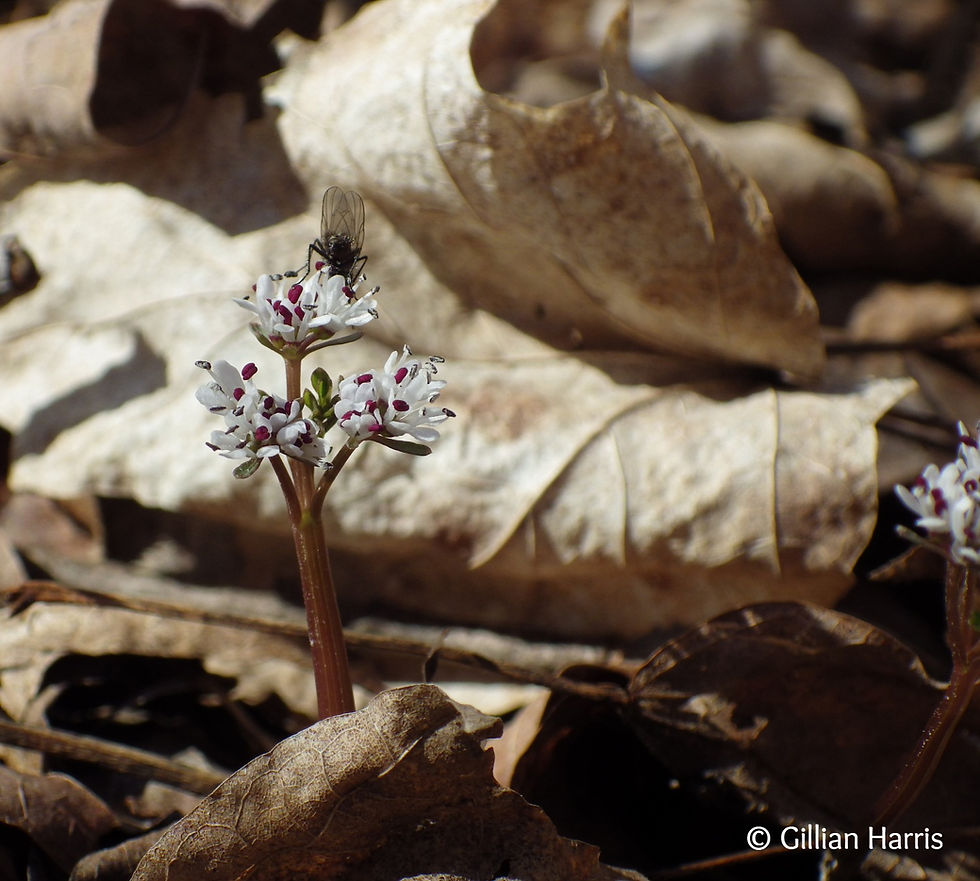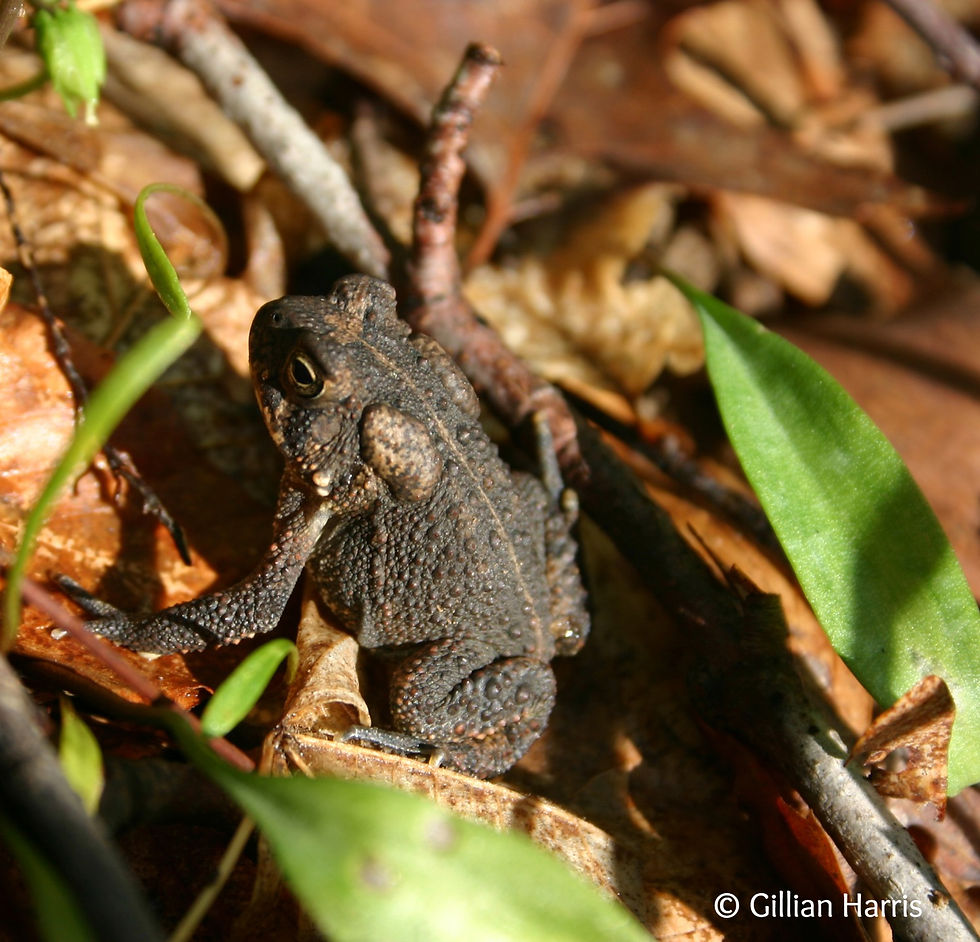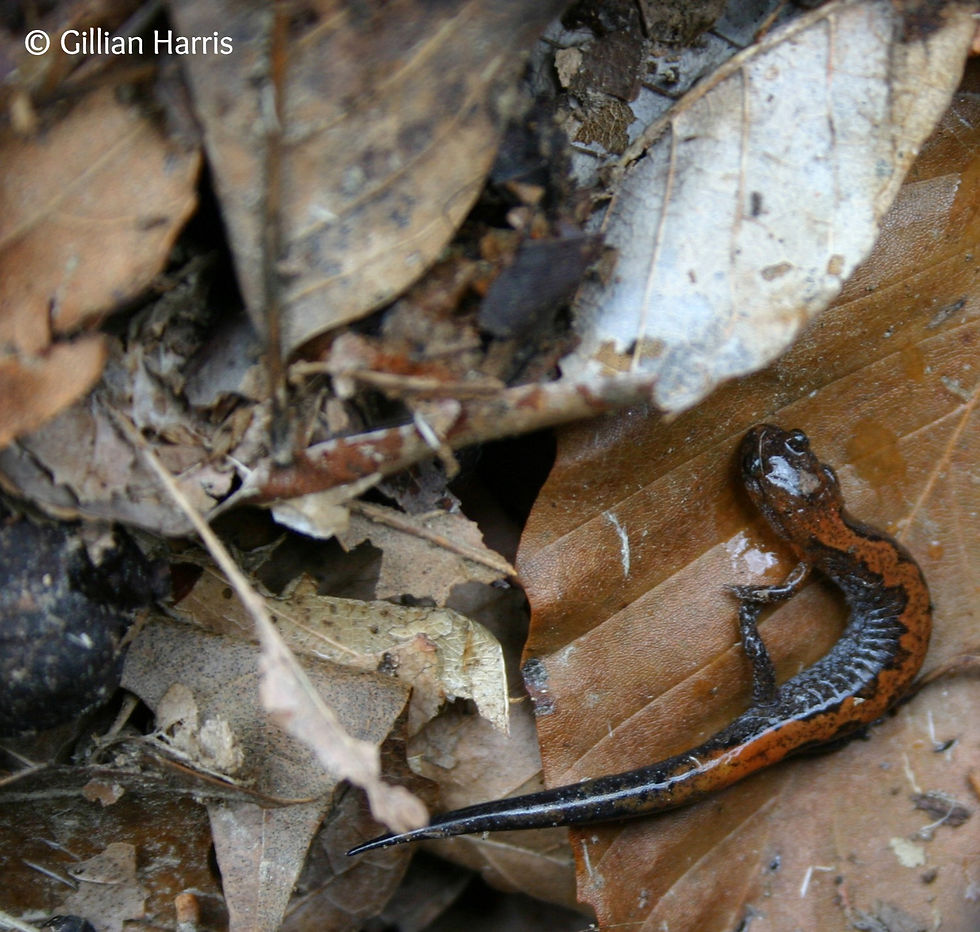
Harbinger of Spring (Erigenia bulbosa), late February
Look carefully at the faded leaves carpeting the forest floor in February and early March, and you’ll see the first wildflowers of—yes, late winter. The aptly named harbinger-of-spring has already pushed through the leaf litter, and is attracting pollinators with its tiny white blooms.
This diminutive member of the carrot family requires full to partial shade, rich loamy soil and moisture to thrive. The dead leaves through which it emerges are a key contributor to its reappearance year after year, as they are to the showier flowers that follow: the trout lily, geranium, white baneberry and fire-pink; and the leafy green ferns and groundcovers that complement them.

Emerging White Baneberry or Dolls' Eyes (Actaea pachypoda)
Woody plants also flourish in the leaf litter. Black oak acorns are often carried into our yard from the adjacent woods and cached there by blue jays. Seedlings that sprout from acorns left in the grass inevitably die soon into their first year, susceptible to the deleterious effects of sun, wind and drought, unable to penetrate the compacted soil or compete with the matted roots of the grass. Acorns cached in our wild shade garden, however--stuffed into the leaf litter, perhaps secreted under a slab of bark or tucked beneath a log, germinated into a far more favorable environment. Several years on these acorns have grown into sturdy saplings that contribute their own leaves to the garden floor. In future these oak trees will support a vast array of wildlife, from leaf-munching caterpillars to the animals that consume them, to the birds and mammals who relish acorns, and to the fungus that feeds on the tree after it dies.

Black Oak (Quercus vellutina) leaves flushing
The leaf-littered earth is an efficacious nursery for young plants; fallen leaves create a microclimate around an emerging wildflower or tree seedling, insulating it from desiccating wind and sun. A layer of dead leaves retains moisture, and contributes to a looser, warmer soil full of nutrients--as well as the fungal hyphae on which many green plants depend for efficient uptake of water and minerals. And a healthy amount of leaf litter, along with logs and branches left to rot on the ground, also generates tremendous animal biodiversity in the garden.

Scarlet Cup Fungus beneath May Apple.

Juvenile Five-lined Skink.
When we plant a landscape for wildlife, we usually aim to attract creatures that dwell with us above ground. We grow native plants with flowers to nourish pollinators--butterflies, moths, bees, and hummingbirds, and leaves that can be eaten by our native lepidopteran larvae, essential food for migrating and nesting birds. We plant native trees and shrubs that offer nutritious seeds and fruits to birds and mammals, and provide wildlife with water and nest boxes and supplemental nourishment in feeders.
But biodiversity at eye-level is dependent on the subtle, seldom seen organisms existing under our feet-- in the soil, the leaf litter, the decaying organic matter. These are the less charismatic dwellers at or below ground level: bacteria, fungus, flea-like springtails, wee arthropods, millipedes, centipedes, worms, snails and slugs, insect pupae. While we’re enjoying the flamboyant high-flying birds and butterflies in our wildlife garden, these creepy-crawlers are going about their business below us, recycling leaves, fallen branches, the fading shoots of spring ephemerals, animal waste—essentially breaking the garden down and building it up again.

American Toad among leaves of Yellow Trout Lily (Erythronium americanum)
These small-scale critters provide sustenance for larger ones: predators such as spiders, salamanders, skinks, snakes, frogs, turtles and toads, all of which use logs as cover and leaves for camouflage, but still take their turn as prey for even larger animals, including the birds and mammals we hoped to attract in the first place.

Zigzag Salamander.
A neatly manicured and mulched lawn and garden is one with fewer places in which life can flourish. If you desire to welcome life into your landscape, consider restraining your rake come autumn. Instead of manhandling those leaves into bags or onto the curb, let them lie, along with rotting logs, sloughed-off bark and fallen branches (some folks like to chop leaves up with lawn mowers or other implements, but keep in mind that the leaf litter also harbors overwintering pupae for moths and other insects). Let the fallen litter provide free mulch, contribute to a functioning food chain and sustain a healthy diversity of plants and animals. Let it form the foundation for a thriving wild garden.












